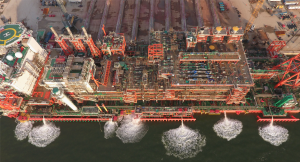Successful Load-out For Jangkrik FPU Project
 Mammoet has safely completed the load-out of the 14,273t Integrated Topside Module (ITM) for the Jangkrik Floating Production Unit (FPU) in Karimun Island, Indonesia. Jangkrik FPU is a part of Jangkrik Complex Project, operated by ENI Muara Bakau B.V. as contractor to SKK Migas, the Indonesian Upstream Oil and Gas Agency. ENI holds a 55% interest in the project. Other Jangkrik partners are ENGIE (33.3%) and PT. Saka Energi Muara Bakau (11.7%). An EPCI contract for the Project was awarded to a consortium led by Saipem which includes Hyundai Heavy Industries (HHI), Tripatra Engineers & Constructors and Chiyoda. The ITM was fabricated by Saipem in their Indonesian yard in Karimun Island while HHI built the hull in Ulsan, South Korea.
Mammoet has safely completed the load-out of the 14,273t Integrated Topside Module (ITM) for the Jangkrik Floating Production Unit (FPU) in Karimun Island, Indonesia. Jangkrik FPU is a part of Jangkrik Complex Project, operated by ENI Muara Bakau B.V. as contractor to SKK Migas, the Indonesian Upstream Oil and Gas Agency. ENI holds a 55% interest in the project. Other Jangkrik partners are ENGIE (33.3%) and PT. Saka Energi Muara Bakau (11.7%). An EPCI contract for the Project was awarded to a consortium led by Saipem which includes Hyundai Heavy Industries (HHI), Tripatra Engineers & Constructors and Chiyoda. The ITM was fabricated by Saipem in their Indonesian yard in Karimun Island while HHI built the hull in Ulsan, South Korea.
Normally, the topside of an FPU is constructed with multiple modules placed individually and integrated on the hull of the vessel. In this unique project, the topside was fabricated and commissioned in one piece on shore, and moved in its entirety onto the hull. This drastically reduced integration time and improved safety. For this project, a hydraulic skidding system with built-in vertical jacks was installed underneath the topside. By using the jacks, the topside was lifted off its temporary supports and performed a calibrated weighing. While supported by the jacks, the topside was skidded over nine skid beams from its construction area to the quayside to prepare for load-out. During the load-out, a computerised ballast system, with a total capacity of 56,000m3/hour, compensated for tidal differences and the weight of the topside and kept the hull perfectly level with the quayside. All the while, the vertical jacks compensated for any deflections of the ITM and the skid beams.
By safely and smoothly performing this operation, Mammoet has begun a new era in which even bigger modules can be loaded onto floating hulls. Topsides can be fabricated and commissioned almost fully on land while hull construction is on-going. This approach reduces integration activities to a minimum, and significantly shortens the overall construction schedule by months.






